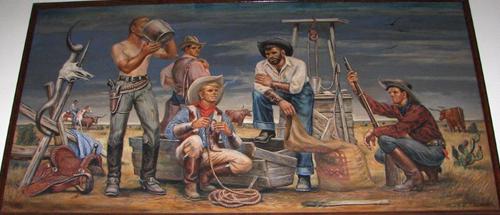|
Way
back in the early 1870s, there was a newspaper operating in Hallettsville
called the Herald and Planter it was printing a weekly edition
and the editor was S. Lee Kyle. According to the Library of Congress,
the Herald and Planter existed from 1872-1887.
It is interesting to note that in the 1870s Texas
was coming out of an economic disaster brought on by the Civil War.
And what was the one major thing that saved Texas?
The answer is wild longhorn
cattle, and the men who gathered them up from out of the mesquite
brush and cactus they formed herds and drove them thousands of miles
up cattle trails to railheads where they were shipped back East to
be devoured by beef-hungry Americans.
Millions of dollars were brought back to Texas
by those daring men who braved the weather, bandits, rustlers, and
Indians to get their herds to market.
And once again, a newspaper becomes an eyewitness to history as it
documents the story of those cattle drives and markets in 1874. This
report comes in the form of a letter out of Topeka, Kansas, and gives
readers an idea of just how valuable cattle
were in those days. The following article was published in the Hallettsville
Herald and Planter it is has been slightly edited. |
 |
Herald
and Planter (Hallettsville), Oct. 15, 1874
A letter from Topeka, Kansas, takes the view which follows of the
Texas cattle trade
for the present year.
The
traffic commenced in the spring with a rather discouraging outlook,
and many drawbacks have attended it during the summer; but despite
of all difficulties it bids fair to turn out larger and more satisfactory
than that of any former year.
There are yet 115,000 wintered cattle
in [Kansas] which will be shipped between now and the first of December.
The number driven this year from Texas,
the bulk of which will be shipped this season, is about 225,000. The
shipments for the entire year 1874 may be safely put at figures in
the neighborhood of 500,000, should nothing interfere with the business
from this time on to the first of January, and the amount of money
involved in the business for the year cannot fall short of $10,000,000,
counting the cattle
at the average price per head in Chicago, and not including young
stock driven from Texas to be wintered.
In addition to the cattle driven into Kansas this year from Texas,
about 50,000 head have been driven to Colorado, and are being fitted
for fall and early winter markets. Quite a large number will also
be wintered in Colorado as well as in Kansas.
The St. Louis Globe notes the arrival in that city of two trains
with cattle
from Flatonia, Texas,
by the Harrisburg and San Antonio Railroad. Flatonia
is about 140 or 150 miles west of Houston,
on the edge of Gonzales
County.
The cattle
were shipped by prominent graziers [cattlemen] half a dozen of them
handled annually 50,000 head. They have been in the habit of sending
droves to Kansas; also, selling for shipment to New Orleans. They
have also sold for shipment to Cuba. But now the Globe says,
they intend to select their best cattle
and ship them to St. Louis. A few days ago they sent a lot on experiment.
Friday the second bunch came, and all were sold at most satisfactory
prices. The owners were so well pleased with the St. Louis market
that they will hereafter ship in large numbers. The Globe says,
That these extensive graziers have now settled upon a well defined
purpose to ship here is a matter for congratulation.
© Murray
Montgomery November
9, 2011 column
More Lone
Star Diary |
|
|
